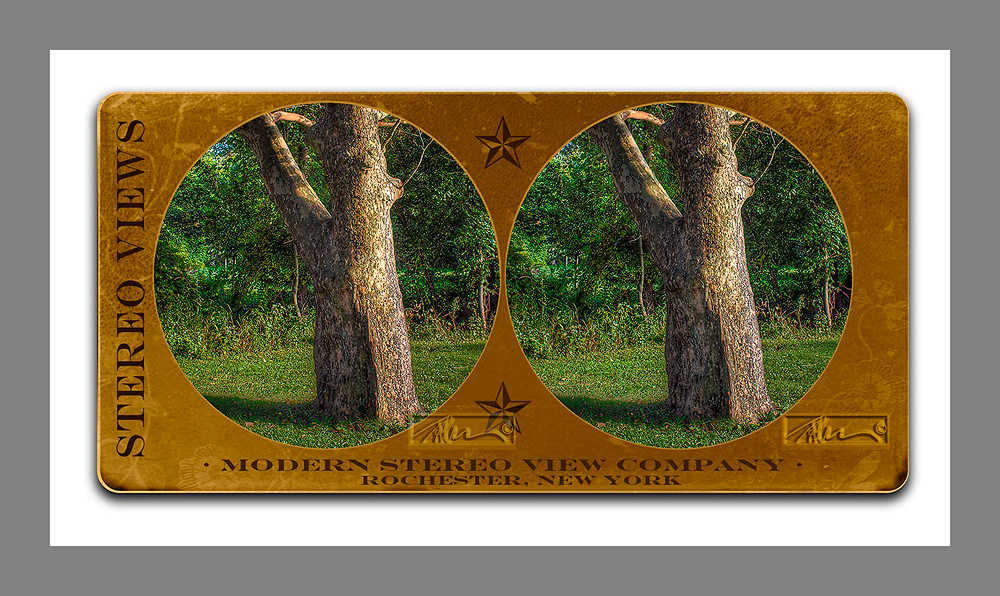Although there are now special digital cameras that can take a stereo pair of images with a single shot, there are ways to shoot stereo using your existing digital camera.
The basic concept of stereo photography mimics human vision by creating two separate views that represent the perspectives of the right eye and the left eye. As long as the subjects in the scene do not move—such as in the case of a landscape or still life – a two shot stereo method can be used.
To take the two pictures, it is important to have the camera at the same height and in a parallel position to the first shot rather than angled toward the subject. Basically, you shoot one image and move the camera horizontally about the same distance as the distance between your eyes and take a second shot. The average ocular distance between most people’s eyes is approximately 65 – 70 mm (21/ 2 inches). This works well for most subjects that are somewhere between 8 – 20 feet in front of the camera. Beyond this distance, the 3D effect starts to diminish.
It is also possible to shoot distant subjects in stereo. The method is the same but the distance between the lenses is greater. This is referred to as hyper-stereo. By increasing the ocular distance between the eyes Hyper stereo essentially shrinks the view. When we view the pairs, the brain sees the subjects as if they were at a normal ocular distance. The reverse is true when shooting close subjects.
In hyper stereo photography, the distance between the taking lenses needs to be adjusted according to the actual distance to the subject. As a general rule, I use approximately 1/30th to 1/50th the distance to the subject. Accordingly, you would need to have about a 2-foot separation for a subject that is 100 feet away to get a good stereo shot.
A wide separation will have an adverse effect on near subjects when viewing the pairs. Therefore it is advisable to avoid including near subjects in the frame when shooting hyper stereo images.
Close-up stereo, referred to, as macro stereo photography requires a separation that is smaller than the normal separation. When photographing a subject such as a flower, you would shoot the first image and then move the camera horizontally using the same rule of roughly 1/30th to 1/50th the distance. If the subject were 10 inches away then the stereo separation the lens separation would be approximately 1/4 inch to 1/2 inch.
While this works for me, I advise taking a series of shots at different separations and view them as stereo images later on the computer.
There are some great devices on the market that will allow you to use a single camera for shooting stereo images. One of the best tools is the Novoflex CastleQ shown in the image above with a DSLR attached. This precision device allows you to shoot an image and move the camera over to the next shot along a moveable rail that is marked in millimeters. This allows you to place the camera exactly where you need it for the second shot. This device is very useful for normal stereo, macro stereo, moderate hyper-stereo and can be used as a macro-focusing rail for general close-up and copy work.
Ideally, a two-camera approach might be the best for situation for shooting stereo images if you can afford to afford duplicate cameras. Even better, it would be great to synchronize the shutters so that they fire simultaneously to capture any motion.
This article assumes the use of a normal or close to normal lens. If a different focal length is used, there are additional factors that need to be adjusted to obtain the best stereo effect. It is a good idea when starting to make a series of images along the same horizontal path that have slightly different positions. Viewing the final images side-by-side using the cross-view method will give you a better idea of the distances for creating future separations with similar subjects.
Watch my blog for more posts about stereo photography.
.
You can read about stereo in my book “Rethinking Digital Photography” here.
Please have a look at some of my other posts here.
NOTICE of Copyright: THIS POSTING AS WELL AS ALL PHOTOGRAPHS, GALLERY IMAGES, AND ILLUSTRATIONS ARE COPYRIGHT © JOHN NEEL AND ARE NOT TO BE USED FOR ANY PURPOSE WITHOUT WRITTEN CONSENT FROM THE WRITER, THE PHOTOGRAPHER AND/OR lensgarden.com. THE IDEAS EXPRESSED ARE THE PROPERTY OF THE PHOTOGRAPHER AND THE AUTHOR.



